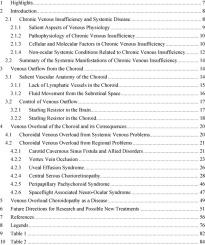Progress in Retinal and Eye Research ( IF 18.6 ) Pub Date : 2021-05-21 , DOI: 10.1016/j.preteyeres.2021.100973 Richard F Spaide 1 , Chui Ming Gemmy Cheung 2 , Hidetaka Matsumoto 3 , Shoji Kishi 4 , Camiel J F Boon 5 , Elon H C van Dijk 5 , Martine Mauget-Faysse 6 , Francine Behar-Cohen 7 , M Elizabeth Hartnett 8 , Sobha Sivaprasad 9 , Tomohiro Iida 10 , David M Brown 11 , Jay Chhablani 12 , Peter M Maloca 13

|
In central serous chorioretinopathy (CSC), the macula is detached because of fluid leakage at the level of the retinal pigment epithelium. The fluid appears to originate from choroidal vascular hyperpermeability, but the etiology for the fluid is controversial. The choroidal vascular findings as elucidated by recent optical coherence tomography (OCT) and wide-field indocyanine green (ICG) angiographic evaluation show eyes with CSC have many of the same venous patterns that are found in eyes following occlusion of the vortex veins or carotid cavernous sinus fistulas (CCSF). The eyes show delayed choroidal filling, dilated veins, intervortex venous anastomoses, and choroidal vascular hyperpermeability. While patients with occlusion of the vortex veins or CCSF have extraocular abnormalities accounting for the venous outflow problems, eyes with CSC appear to have venous outflow abnormalities as an intrinsic phenomenon. Control of venous outflow from the eye involves a Starling resistor effect, which appears to be abnormal in CSC. Similar choroidal vascular abnormalities have been found in peripapillary pachychoroid syndrome. However, peripapillary pachychoroid syndrome has intervortex venous anastomoses located in the peripapillary region while in CSC these are seen to be located in the macular region. Spaceflight associated neuro-ocular syndrome appears to share many of the pathophysiologic problems of abnormal venous outflow from the choroid along with a host of associated abnormalities. These diseases vary according to their underlying etiologies but are linked by the venous decompensation in the choroid that leads to significant vision loss. Choroidal venous overload provides a unifying concept and theory for an improved understanding of the pathophysiology and classification of a group of diseases to a greater extent than previous proposals.
中文翻译:

静脉超负荷脉络膜病变:中心性浆液性脉络膜视网膜病变和相关疾病的假设框架
在中心性浆液性脉络膜视网膜病变 (CSC) 中,由于视网膜色素上皮水平的液体渗漏,黄斑脱离。液体似乎起源于脉络膜血管通透性过高,但液体的病因是有争议的。通过最近的光学相干断层扫描 (OCT) 和广域吲哚菁绿 (ICG) 血管造影评估阐明的脉络膜血管发现表明,患有 CSC 的眼睛具有许多与涡静脉或颈动脉海绵状血管闭塞后眼睛相同的静脉模式窦瘘(CCSF)。眼睛显示延迟的脉络膜充盈、扩张的静脉、涡旋静脉吻合和脉络膜血管通透性过高。虽然涡静脉或 CCSF 闭塞的患者有眼外异常导致静脉流出问题,患有 CSC 的眼睛似乎有静脉流出异常作为一种内在现象。控制从眼睛流出的静脉涉及 Starling 电阻效应,这在 CSC 中似乎是异常的。在视乳头周围厚脉络膜综合征中也发现了类似的脉络膜血管异常。然而,视乳头周围厚脉络膜综合征有位于视乳头周围区域的涡旋静脉吻合,而在 CSC 中,这些吻合位于黄斑区域。与航天相关的神经眼综合征似乎与脉络膜异常静脉流出的许多病理生理问题以及许多相关的异常有关。这些疾病根据其潜在病因而有所不同,但与脉络膜中的静脉失代偿有关,导致严重的视力丧失。











































 京公网安备 11010802027423号
京公网安备 11010802027423号